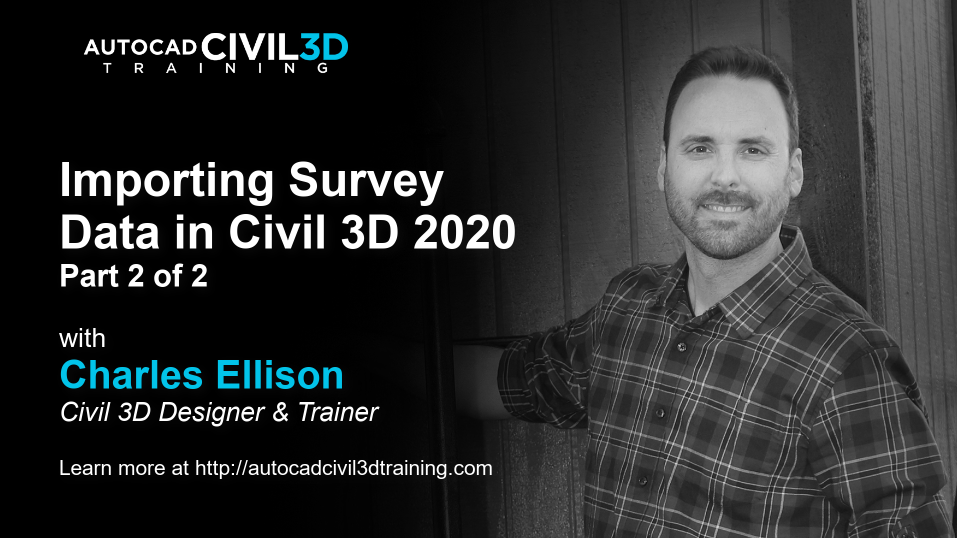Hi, I’m Charles Ellison, Civil 3D Designer and Trainer at autocadcivil3dtraining.com. Today we’ll continue with looking at Importing Survey Data in Civil 3D 2020. Remember that when we import data from the field, we have two options. We can import the data directly into the drawing, but others working on the project won’t have access to it. However, if we import the data into a survey database on a network, then we can share it with others working on the project.
Now again we chose to import survey data, so it’s a wizard it’s going to walk us to the next step where is that data coming from. And notice the four different ways that we can bring data into the database. Most of these are external files but the last one is points from drawing. So we could have points that are in the drawing that are not in the database. And we want to bring those points into the database. Remember that’s all we’re doing is working on the database. But we’re going to be working with a point file it’s an external file. Let’s go ahead and select that point file, the plus sign here got to desktop, exercises and we’re going to choose chapter three and you’ll find that text file right there.
Now there’s quite a few different file types that can be used to import this information, click OK or open and the software does its best to guess the file format found within that external point file. It guessed that is E and Z; it guessed wrong, it’s about 80% correct it’s the one time that we stopped looking that it guesses wrong. So make sure you always pay attention to the preview and the format it applied. This file was actually a point number northing, easting, elevation, description comma delimited file format. So I select that file format you see the preview improves and I go ahead and click Next.
The next portion of this wizard is to create a network for dealing with these points. Now network is similar to setting up our Traverse. So again if we’re dealing with any translation or adjustments once the data is brought into a civil treaty survey database then you’ll want to apply these points to the correct network your control your Traverse control for those points. In this case we’ve already made the adjustments, so we’re not going to have a network assigned. I click Next and this is kind of a last look at what is going to do. Is going to bring all the points in to the point survey database. It’s going to name the import of these survey points into that database as the name of the file by default.
And do we want to go ahead and create line work in the drawing? Sure, I’ll check the box and it will process the line work using the sample figure prefix database and the line work code set, the sample line work code setting. Then lastly do we want to go ahead and import survey points? Sure, so I check both of these and I also set to insert those figure lines into this drawing and I finish. And you’ll see the points come in, it draws the line work for us, but more importantly if I come over to the survey database you’ll notice my new survey database of LinkedIn. And I have a new import event of that text file. It also stores all the figures that were drawn based upon the codes Curb, island or TC and then kind of collects the different ones in groupings here.
Lastly the points that are stored in that database are listed in my survey points. This is very powerful the way it categorizes everything because for example if you ever needed to get rid of points in the database every single import event is stored separate and you can even manage those survey points per import event. There was a project we worked on and we were about two weeks in and then we noticed the prism was off and so all those points we imported, we had to get rid of because we had those import events, it was very easy to go back and clear out the bad points and then begin to pick up again where we left off. We did lose some work but within the drawing, within what we were reducing it was much easier to work and clean up. So we have our import event set up but if you notice here our figures aren’t the prettiest. We have quite a bit, there’s no real curvature to them, we have some issues over here. So let’s see how we can manage these figures in our next drawing.


